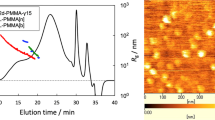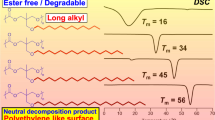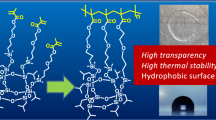Abstract
The poly(methyl methacrylate)s (PMMAs) differing in their tacticity were investigated by liquid chromatography at the critical adsorption point (LC CAP). The set of chromatographic conditions (eluent composition determining its adsorption strength, column packing nature and temperature) was identified for given highly stereoregular PMMAs, under which the exclusion of polymer chain from the pores (entropic effect) was just compensated by the adsorption of the polymer chain on the column packing surface (enthalpic effect). The result was that no separation according to the solute molar mass took place. Using bare silica gel column packing and tetrahydrofuran (THF)/n-hexane mixture as eluent at 30°C, syndiotactic (st-) PMMAs were more readily adsorbed on the column packing surface than isotactic (it-) PMMAs. The critical adsorption point (CAP) for st-PMMAs was reached with the eluent composition THF/n-hexane (83.2/16.8, w/w). Under the same conditions, however, it-PMMAs were eluted in the size exclusion chromatography (SEC) mode and the separation was achieved for mixtures of it-PMMA and st-PMMA of lower molar mass. With the same bare silica gel as the stationary phase and chloroform (CHCl3)/ethanol or CHCl3/THF mixtures as eluents at 30°C, st-PMMAs were less adsorbed on column packing and they eluted in the SEC mode while the CAP was reached for it-PMMAs, i.e., CHCl3/ethanol (97.2/2.8, w/w) or CHCl3/THF (87.7/12.3, w/w). By using latter non-aggregating mixed eluents containing chloroform, the satisfactory separation of st- plus it-PMMA mixtures were achieved even for polymers with molar masses exceeding 100000 g mol−1. The results indicate the potential of liquid chromatographic procedures that combine exclusion and adsorption mechanisms in separation of macromolecules according to their stereoregularity. Further, the advantages of the LC CAP mixed eluents is demonstrated that are composed solely of the solvents for polymers under study.
Similar content being viewed by others
Login or create a free account to read this content
Gain free access to this article, as well as selected content from this journal and more on nature.com
or
References
K. Hatada, K. Ute, T. Kitayama, M. Yamamoto, T. Nishimura, and M. Kashiyama, Polym. Bull., 21, 498 (1989).
D. Berek, M. Janco, T. Kitayama, and K. Hatada, Polym. Bull., 32, 629 (1994).
B. G. Belenkii, E. S. Gankina, M. B. Tennikov, and L. Z. Vilenchik, Dokl. Akad. Nauk SSSR, 231, 1147 (1976).
H. Pasch, Macromol. Symp., 110, 107 (1996).
R. Murgasova, D. Berek, and I. Capek, in International Conference on Macromolecules, Bratislava, 1995, p 113.
S. G. Entelis, V. V. Evreinov, and A. V. Gorshkov, Adv. Polym. Sci., 76, 129 (1987).
M. Janco, D. Berek, A. Onen, Ch.-H. Fischer, Y. Yagci, and W. Schnabel, Polym. Bull., 38, 681 (1997).
K. Hatada, K. Ute, K. Tanaka, Y. Okamoto, and T. Kitayama, Polym. J., 18, 1037 (1986).
T. Kitayama, T. Shinazaki, E. Masuda, M. Yamamoto, and K. Hatada, Polym. Bull., 20, 565 (1988).
S. Mori and Y. Uno, J. Appl. Polym. Sci., 34, 2689 (1987).
H. J. A. Philipsen, B. Klumperman, A. M. van Herk, and A. L. German, J. Chromatogr., A727, 13 (1996).
D. Berek, Macromol. Symp., 110, 33 (1996).
H. Sato, M. Sasaki, and K. Ogino, Polym. J., 23, 23 (1991).
Author information
Authors and Affiliations
Rights and permissions
About this article
Cite this article
Berek, D., Janco, M., Hatada, K. et al. Separation of Poly(methyl methacrylate)s According to Their Tacticity II. Chromatographic Investigations of Poly(methyl methacrylate)s with Different Tacticity at the Critical Adsorption Point. Polym J 29, 1029–1033 (1997). https://doi.org/10.1295/polymj.29.1029
Issue date:
DOI: https://doi.org/10.1295/polymj.29.1029
Keywords
This article is cited by
-
Two-dimensional liquid chromatography of synthetic polymers
Analytical and Bioanalytical Chemistry (2010)
-
Adsorption and enthalpic partition retention mechanisms in liquid chromatography of non-charged synthetic polymers
Chromatographia (2003)
-
Liquid chromatography of macromolecules at the point of exclusion—adsorption transition
Materials Research Innovations (2001)



